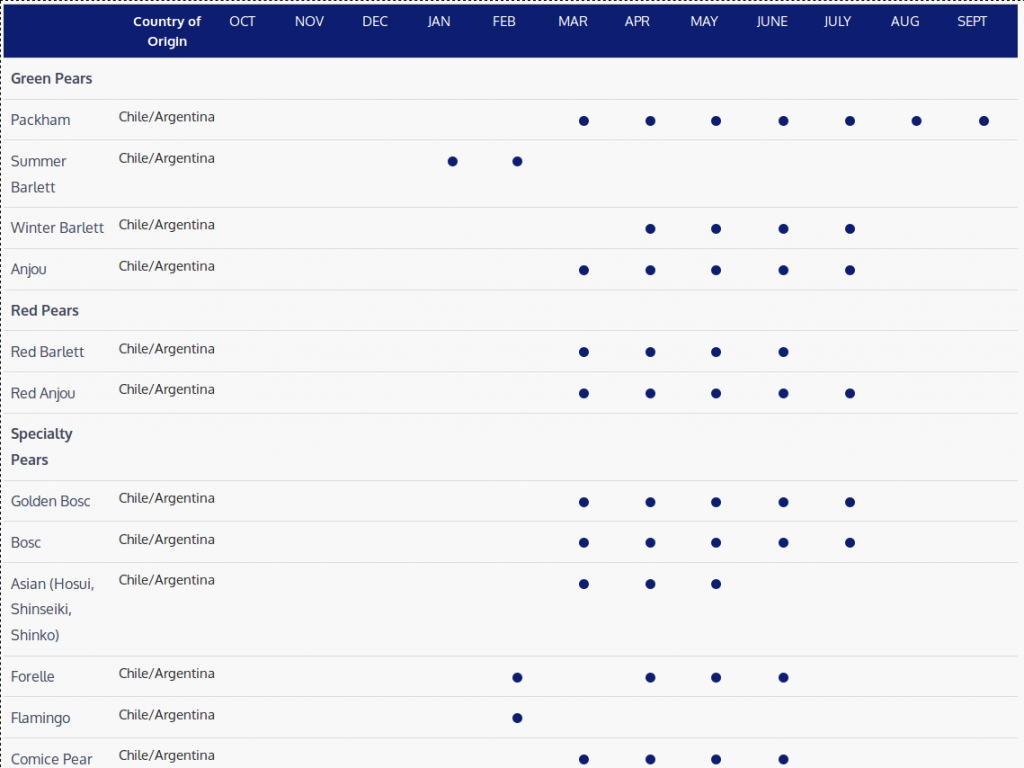- Contact Us | Call Us at +1 845-883-7351
| Country of Origin | OCT | NOV | DEC | JAN | FEB | MAR | APR | MAY | JUNE | JULY | AUG | SEPT | |
Green Pears |
|||||||||||||
Packham |
Chile/Argentina | ||||||||||||
Summer Barlett |
Chile/Argentina | ||||||||||||
Winter Barlett |
Chile/Argentina | ||||||||||||
Anjou |
Chile/Argentina | ||||||||||||
Red Pears |
|||||||||||||
Red Barlett |
Chile/Argentina | ||||||||||||
Red Anjou |
Chile/Argentina | ||||||||||||
Specialty Pears |
|||||||||||||
Golden Bosc |
Chile/Argentina | ||||||||||||
Bosc |
Chile/Argentina | ||||||||||||
Asian (Hosui, Shinseiki, Shinko) |
Chile/Argentina | ||||||||||||
Forelle |
Chile/Argentina | ||||||||||||
Flamingo |
Chile/Argentina | ||||||||||||
Comice Pear |
Chile/Argentina |

Sweet and juicy when crisp, you may not want to wait for Golden Bosc pears to ripen. This classic dessert pear is considered a fruit of choice. Its highly aromatic scent will help your home smell and feel like a holiday.
Large, long-necked fruit that ripens to a greenish yellow, usually completely overlaid with a cinnamon-colored russet. Fruit quality is excellent for all uses. Good pollinizer for Bartlett.
The term Asian pear describes a large group of pear varieties having crisp, juicy fruit. When mature, the fruit are good to eat when harvested or for several months after picking if held in cold storage. The crisp texture of an Asian pear remains unchanged after picking or storage, unlike the flesh of European pears such as Bartlett or Comice. There are three types of Asian pear: round or flat fruit with green to yellow skin; round or flat fruit with bronze-colored skin and a light bronze-russet; and pear-shaped fruit with green or russet skin.
The Forelle pear is a small variety, with a luscious texture and complex flavor. The fruit is buttery, with a faint but discernible cinnamon spiciness. What it lacks in size, it more than compensates for on the tongue.
Flamingo pears are an early-season variety easily recognizable by their attractive red blush. The fruit is oblong in form and has moderate storage ability. It’s sweet, soft flesh make for an excellent snacking fruit.
Comice pears were first cultivated in the mid-1800s near Angers, France. The official name for this pear variety is Doyenné du Comice. In the 1900s, the first red sports were found to be growing in orchards near Medford, Oregon. Comice pears may be smaller in size, but they are big on flavor. They are one of the sweetest and juiciest of all of the pear varieties.
An enormously popular pear, conspicuous for its attractive green skin, but with a typical pear shape. Demand for this variety is growing rapidly throughout the world. Consumer tips: Serve ripe or store in a refrigerator. Ripe pears will keep for several days when refrigerated.
Large, clear, juicy, buttery, and excellent thrifty, young, heavy and reliable bearer, too well known to need any lengthy description; one of the best fruits ever introduced. Valuable for home use and perhaps as profitable as any fruit that is grown for markets.
The Winter Bartlett totes all the same fantastic features of traditional Bartletts—soft, juicy flesh and a buttery texture resulting in a pear packed with flavor. This particular variety has a late season, allowing for a lengthened Bartlett season.
The fruit has a bell shape, considered the traditional pearshape in the west, and its green skin turns yellow upon later ripening, although red-skinned derivative varieties exist. It is considered a summer pear, not as tolerant of cold as some varieties. It is often eaten raw, but holds its shape well when baked, and is a common choice for canned or other processed pear uses.
The French d’Anjou is a large white-fleshed pear with abundant juice and a sweet brisk flavor. French Anjou pears are thought to have originated in France, in the vicinity of Angers. Called Beurre d’Anjou, they were introduced to America in about 1842. The name has been shortened simply to “Anjou”, and is sometimes pronounced to rhyme with “Banjo”, though it it still properly listed by its original French name. Unlike Royal Williams (or Bartletts), another familiar green pear variety that does change to yellow during ripening, Green Anjous will remain green even when fully ripe. Anjou pears have exceptional keeping qualities, but are best when sliced and eaten fresh.
Similar to Bartlett but the skin has a dark red blush, highly flavored and juicy. Fruit should be picked before fully ripened. Good-quality Red Bartlett pears will be medium-sized or larger with no bruises and only a few minor scuff marks. The coloring will be medium-red to brownish-red. Bartlett pears are ripe when they give off a sweet aroma.
Red Anjou pears are much like their Green Anjou counterparts in all respects other than color.
Their shape, flavor and texture are virtually identical. It’s their deep, rich, maroon color that sets this variety apart, particularly as a showy pear among pears in a fruit bowl or basket.
